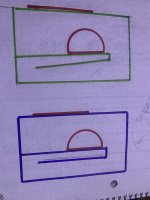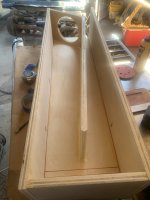It's response would be different, my guess it would have more pronounced odd order resonances that would ring for a longer time period.What about a stepped version of the Keystone to eliminate angles?
At minimum, a reshape/resize of the exit would be required to make the response similar.
Art
Too bad it’s kind of an expensive experiment and drivers …. Studying the pipe vs ‘cone/horn’ shape in a similar size and tuning qw resonator/tapped pipe/horn type things would be interesting.
what about adding that "acoustic denim" thing inside the walls
to mitigate the resonances like on TL's and BP's designs
i know that will cost maybe 2db or 3 but that is collateral damage
pursuing a simpler build process
people will need to double their cabinet count if any to reach the same
SPL as the original design..
Want an easier build....pay the price with less SPL
So.... make more cabinets!
but i guess many folks will pay the price if the build is going to be 90 degree panels inside
to mitigate the resonances like on TL's and BP's designs
i know that will cost maybe 2db or 3 but that is collateral damage
pursuing a simpler build process
people will need to double their cabinet count if any to reach the same
SPL as the original design..
Want an easier build....pay the price with less SPL
So.... make more cabinets!
but i guess many folks will pay the price if the build is going to be 90 degree panels inside
Last edited:
I used straight cuts for my panels when I built mine. Around the smallest panel of the horn (top panel of the horn) there is a lot of pressure building up, I dont remember if I used regular wood glue or polyurethane glue but it broke. I didn't use screws, only small nails from my nail gun. Screws+glue would probably be fine. Should be ok as a first project, just prepare accordingly and think about the steps beforehand, and/or proceed slowly. Good luck!
This is good to know, as most builds I've done have been nothing but PL adhesive and brads. I'll be sure to use countersunk screws wherever possible!
If I follow, Danley once made a point of backing me up when I stated that a bend must always be expanding or it will act as a low pass filter, though sometimes referred to (in error?) as bass trap.Does the vibrating air really get messed up so terribly dufferent if you change the csa at the ends of sections instead of taper it throughout? I’m sure someone can find decent results either way
So in a TH bends must expand ...can't be 90 degree turns like in TL's...otherwise what you gain you loose getting less bass out ....
Holly frijoles batman!!
Holly frijoles batman!!
I'm way too impatient to use screws everywhere, but with the keystone for sure I would use screws for the small top panel of the horn where it meets the baffle and second horn panel. Maybe a brace somewhere if I got the impression it was a bad fit (due to my impatience when cutting it) and would risk vibrate loose I would screw it down too. Otherwise I would only use brad nails and glue for 99% of the build. Finishing countersunk screws with putty is a nightmare IMO also.This is good to know, as most builds I've done have been nothing but PL adhesive and brads. I'll be sure to use countersunk screws wherever possible!
Last edited:
What about the turns in all my tapered pipes? There’s a bump in the crossectional area in each corner full of air that’s just ‘stuck’ there essentially. But theres a ‘smooth decrease’ in the pipe shape through the turn if you ignore those and just measure off that tilted panelSo in a TH bends must expand ...can't be 90 degree turns like in TL's...otherwise what you gain you loose getting less bass out ....
Holly frijoles batman!!
Attachments
Last edited:
what i meant is that each CSA is bigger than the last
thus forming a HORN where the throaty is smaller than the mouth
if you dont have expaning CSA you end up with a TL where you cant offset the driver
right ?
thus forming a HORN where the throaty is smaller than the mouth
if you dont have expaning CSA you end up with a TL where you cant offset the driver
right ?
you can offset the driver in anything, but the ‘horn’ shape pushes the low pressure area of the second resonance down further than ‘1/3’ . its near halfway in the cone shaped closed end resonator pic ART shared up above
Neither 1!I don't mess with putty, bondo is the way!
I wanted to spray paint the whole enclosure cause carpeting $\_/Cl<$ too.
When you carpet a car cabinet
It makes so much friction that it's a bitch to move when you want to pull it off the trunk,
But that is a life saver when you slam the brakes
And you dont end decapitated when an idiot dont respect a red light!🤣
It makes so much friction that it's a bitch to move when you want to pull it off the trunk,
But that is a life saver when you slam the brakes
And you dont end decapitated when an idiot dont respect a red light!🤣
Luckily, I have the fuel tank between the enclosure and the back seat...is that a good thing???
Well at least the flames will burn you to the bone before the enclosure hit where you head used to be and by the time reduced to a handful of ashes.😆
Screws weakens construction; better to use glue blocks, Titebond 3 or similar, though if still wanting screws, then stagger them.I'm way too impatient to use screws everywhere, but with the keystone for sure I would use screws for the small top panel of the horn where it meets the baffle and second horn panel. Maybe a brace somewhere if I got the impression it was a bad fit (due to my impatience when cutting it) and would risk vibrate loose I would screw it down too. Otherwise I would only use brad nails and glue for 99% of the build. Finishing countersunk screws with putty is a nightmare IMO also.
- Home
- Loudspeakers
- Subwoofers
- Keystone Sub Using 18, 15, & 12 Inch Speakers

